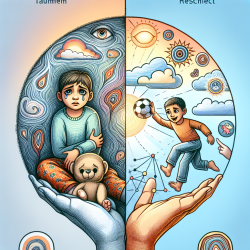Post-traumatic stress disorder (PTSD) is a prevalent mental health issue affecting many children and adolescents who have experienced trauma. The impact of PTSD on young individuals can be profound, affecting their emotional, social, and academic lives. As a practitioner working with this vulnerable population, staying informed about the most effective treatment options is crucial.
The recent study titled "Comparative efficacy and acceptability of psychotherapies for post-traumatic stress disorder in children and adolescents: study protocol for a systematic review and network meta-analysis" offers valuable insights into this area. This research aims to establish a hierarchy of psychotherapies based on their efficacy and acceptability, providing a clearer path for clinical decision-making.
The Need for Comprehensive Evaluation
The study highlights the importance of evaluating various psychotherapies to determine their effectiveness in treating PTSD in young people. Traditional meta-analyses often fall short as they cannot compare all available treatments simultaneously. This is where network meta-analysis comes into play, allowing researchers to integrate direct and indirect evidence from multiple studies to estimate the interrelations across all treatments.
This comprehensive approach not only provides a clearer picture of which therapies are most effective but also helps identify potential moderators that could influence treatment outcomes. For practitioners, this means having access to higher-quality evidence that can guide treatment choices more effectively.
Key Findings and Implications
- Efficacy at Post-Treatment: The primary outcome measured was PTSD symptom severity at post-treatment. Understanding which therapies offer the most significant reduction in symptoms can help practitioners tailor interventions to individual needs.
- Acceptability: The study also examined treatment acceptability by looking at all-cause discontinuation rates. Knowing which therapies are more likely to be completed by patients can inform decisions about which treatments to recommend.
- Anxiety and Depressive Symptoms: Secondary outcomes included improvements in anxiety and depressive symptoms, which are often comorbid with PTSD. This holistic view ensures that treatment plans address the full spectrum of a child's mental health needs.
- Quality of Life Improvements: Enhancing a child's quality of life is a critical goal of any therapeutic intervention. The study's findings on functional improvement can guide practitioners in selecting therapies that not only reduce symptoms but also improve overall well-being.
Encouraging Further Research
The study underscores the need for ongoing research into psychotherapies for PTSD in children and adolescents. As new therapies emerge and existing ones evolve, staying abreast of the latest evidence is essential for practitioners committed to providing the best care possible.
This research serves as a call to action for practitioners to engage with current studies actively, apply findings in clinical settings, and contribute to further investigations. By doing so, we can collectively improve outcomes for young patients struggling with PTSD.










